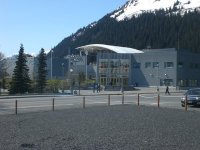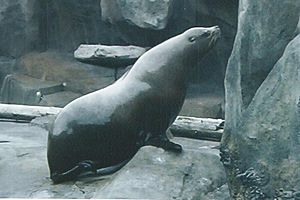Alaska SeaLife Center facts for kids
 |
|
| Date opened | May 20, 1998 |
|---|---|
| Location | Seward, Alaska |
| Land area | 115,000 square feet (10,700 m2) |
| Coordinates | 60°06′00″N 149°26′27″W / 60.10000°N 149.44083°W |
The Alaska SeaLife Center is a special place in Seward, right on the coast of Resurrection Bay. It's a public aquarium where you can see amazing sea creatures. It's also the only permanent center in Alaska that helps injured or sick marine mammals get better.
The center opened its doors in May 1998. Its main goal is to learn about and protect Alaska's ocean environment, called its marine ecosystem. They do this through scientific research, helping animals, working to save species, and teaching people. It's the only place in the world built to study the northern ocean and teach the public at the same time. The Alaska SeaLife Center shares what it learns to help everyone understand and care for Alaska's marine life.
Building the Alaska SeaLife Center cost about $55 million. A big part of this money, $37.5 million, came from a special fund related to the Exxon Valdez oil spill. This money was set aside for research and helping animals. The center also raised money by selling bonds and getting donations from local people.
The Alaska SeaLife Center is a private, non-profit organization. This means it doesn't operate to make money. It has about 105 full-time employees. Many volunteers and interns also help out. In September 2011, the center received a special award called accreditation from the Association of Zoos and Aquariums. This shows that the Alaska SeaLife Center is one of the best aquariums and zoos in the country. Less than 5% of these facilities have this high standard.
Contents
Researching Alaska's Ocean Life
The Alaska SeaLife Center is unique because it has both a public aquarium and a full research facility in the same building. This allows scientists to study animals up close. The center works with the University of Alaska Fairbanks. They also team up with many other state, federal, and international groups and universities.
Scientists at the SeaLife Center study Alaska's marine ecosystems. They learn about the animals that live there. This includes marine mammals, seabirds, fish, and small ocean creatures called invertebrates. Some of these animals are even listed as threatened or endangered. The center focuses on animals like Steller sea lions, eiders (a type of duck), harbor seals, sea otters, and fur seals. These animals have seen their numbers drop in Alaska.
The research team works hard to create new ways to study these animals. They try to do their research without disturbing the animals or their environment too much. The Science Department has special programs. These programs focus on pinnipeds (like seals and sea lions), eiders, sea otters, and salmon.
Helping Sick and Injured Marine Animals
The Alaska SeaLife Center has a special program to care for sick and injured marine animals. This program helps them learn important things about wild animal populations. They rescue, treat, and then release stranded animals. The center tries its best to help every rescued animal get healthy enough to go back to its natural home. The main goal is always to return healthy animals to the wild.
Many types of stranded marine animals are brought to the center. These include harbor, ringed, spotted, and fur seals. They also care for Steller and California sea lions, walruses, sea otters, and many kinds of birds. These animals come from all over Alaska. They receive medical care and rehabilitation. If an animal cannot be released, it might stay at the Alaska SeaLife Center. Sometimes, it might be moved to another facility.
The Alaska SeaLife Center is the only permanent place in Alaska that helps stranded marine mammals. Because it's part of a research facility, veterinarians and staff learn a lot about these animals. This happens while they are being cared for.
The rescued animals teach the center about their bodies and how they work. This information helps scientists protect threatened and endangered species. The program also helps keep an eye on wild animal populations. They do this by studying sick or orphaned marine mammals and birds. Through their communication and education programs, more people learn about the ocean. They also learn why it's so important to our planet.
The Rescue and Rehabilitation Program has permission from government agencies. These agencies are NMFS (National Marine Fisheries Service) and USFWS (U.S. Fish and Wildlife Service). This allows them to help marine mammals and birds that are stranded along the entire Gulf Coast of Alaska. The program has a team of veterinarians, interns, and volunteers. They are all trained to care for these animals.
Learning and Discovery Programs
The Discovery Education programs at the SeaLife Center are designed to meet Alaska's and national science education standards. They offer programs all year long. You can join Day Programs or even stay overnight for Nocturne Sleepovers. The center also offers Outreach Programs. These can be presented in schools in the Anchorage, Mat-Su, and Kenai Peninsula areas. They even have Distance Learning programs. These use video conferencing to teach people all over the world!
Amazing Exhibits to Explore
The center has many exciting exhibits for visitors. One popular spot is the touch tank. Here, you can gently touch small marine invertebrates. These include sea stars and sea urchins in a shallow pool. There's also a large aviary for the center's many seabirds. It has a two-story diving pool for them. This pool also houses a wolf eel and several types of large saltwater fish.
Other tanks and exhibits feature harbor seals and Steller's sea lions. You can also see colorful nudibranchs, glowing moon jellies, unique gruntsculpins, and giant Pacific octopuses. There are also exhibits showing Alaska's important food fish. These include salmon, halibut, king crab, and sablefish. In 2016, the center opened the Nose 2 Nose exhibit. This area makes the underwater viewing even better. It has a new Octopus Grotto where you can learn more about the octopuses living there. The exhibit also has fun activities and displays for families. You can get eye-to-eye with octopuses, sea lions, seals, and many fish and bird species.
See also
 In Spanish: Alaska SeaLife Center para niños
In Spanish: Alaska SeaLife Center para niños


